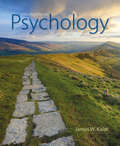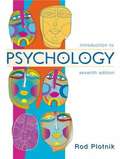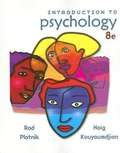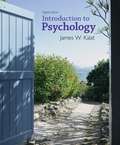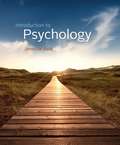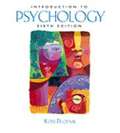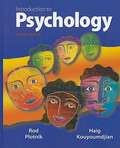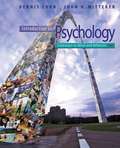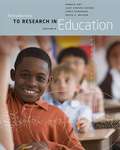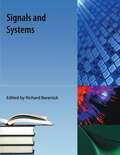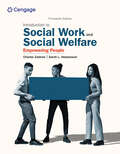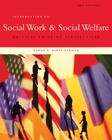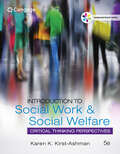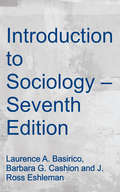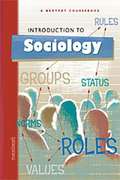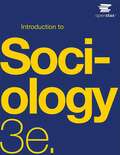- Table View
- List View
Introduction to Psychology
by Hawkes Learning SystemsIntroduction to Psychology offers students a comprehensive guide to core psychological concepts. Aligned with APA learning outcomes, the course emphasizes disciplinary diversity and the skeptical habits of a scientific mind. It features engaging, interactive practice and contemporary, multi-modal learning that foster a meaningful exploration of a vast and growing field. <p><p>In a conversational tone, Introduction to Psychology leads students to a foundational and relevant understanding of psychology through a consistent focus on applying concepts in their own lives.
Introduction to Psychology
by James W. KalatJim Kalat's best-selling INTRODUCTION TO PSYCHOLOGY takes an "evaluate the evidence" approach that features a friendly writing style, hands-on "Try It Yourself" activities, and helpful visuals to invite students to engage in the experience of learning psychology. The modular organization breaks each chapter into meaningful "chunks" for structuring learning. Content is seamless, with nothing relegated to the margins or separated in boxes. "What's the Evidence" coverage reviews real studies, encouraging students to ask questions like, "Does the evidence really support the conclusion?" The Eleventh Edition draws on the latest research and literature to teach students how to separate the plausible from the scientifically demonstrable in the psychology classroom and beyond it. Instructor resources include an author-written test bank, ensuring high-quality, and accurate multiple-choice questions for assessment.
Introduction to Psychology
by Mcdougal LittellSome of the topics covered in this book include: the world of psychology, research in psychology, psychology & the brain, sensation, perception, consciousness, learning, memory and intelligence among others.
Introduction to Psychology Version 2.1
by Charles StangorIntroduction to Psychology Version 2.1 was collated to help students organize their thinking about psychology at a conceptual level.
Introduction to Psychology (7th Edition)
by Rod PlotnikDrawing students into psychology using a unique "magazine-style" format, Rod Plotnik's modular, visually-oriented approach to the fundamentals makes even the toughest concepts engaging and entertaining. Incorporating the latest research updates, the text breaks concepts down into small, easily digested chunks that allow students and instructors great flexibility in their approach to the subject. For students, this means the flexibility to learn at their own pace; for instructors, the flexibility to assign as much or as little as they like. This Seventh Edition expands upon Plotnik's commitment to teaching by extending the text's approach into its comprehensive ancillary package. For students, "Learning Links" features in the text connect them to the newly updated PowerStudy 2. 0 CD-ROM (see below for details). In addition, students have free access to a Book Companion Web Site that now includes personalized Self-Study Assessments-giving them even further assistance in reviewing and prioritizing study time for maximum effectiveness. For instructors, a detailed ancillary package centered around a comprehensive Instructor's Resource Manual provides everything needed for easier, more effective course preparation.
Introduction to Psychology (8th Edition)
by Rod Plotnik Haig KouyoumdjianLike reading a magazine-not studying from a text-Plotnik's Introduction to Psychology 8e will draw you in and show you how visual and exciting the study of psychology can be. Rod Plotnik's modular, visually-oriented approach to the fundamentals of psychology makes even the toughest concepts engaging and entertaining. Incorporating the latest research updates, the text breaks concepts down into small, easily digested chunks that give you and great flexibility how you approach and study the subject.
Introduction to Psychology (8th edition)
by James W. KalatFocusing on one type of behavior at a time, this textbook examines the roles biology, learning experiences, and social influences play in human intelligence, memory, perception, states of consciousness, cognition, motivation, and personality. The eighth edition updates references and adds sections on synesthesia, procrastination, and decision making. Annotation ©2007 Book News, Inc., Portland, OR (booknews.com)
Introduction to Psychology (Tenth Edition)
by James W. KalatJames Kalat's best-selling INTRODUCTION TO PSYCHOLOGY does far more than cover major theories and studies; it encourages you to question the information and ask yourself, "How was this conclusion reached?" and "Does the evidence really support it?" In this student-praised text, Kalat challenges your preconceptions about psychology to help you become a more informed consumer of information not only during your college experience but also as you venture into your post-college life. With his humorous writing style and hands-on "Try It Yourself" exercises, Kalat puts you at ease and gets you involved with what you are studying so that you can succeed in your course.
Introduction to Psychology 6th Edition
by Rod PlotnickThis introductory text is organized by self-contained modules rather than chapters, and features integration of colorful graphics and photos with text in smaller one- and two-page units. Material is accessibly written yet detailed, with illustrated explanations of difficult concepts related to physical and biochemical aspects, and many references to news events, public figures in entertainment and politics, and ongoing real-life cases. Other learning features include concepts reviews, summary tests, critical thinking exercises, and quizes. Plotnik teaches at San Diego State University. Annotation c. Book News, Inc. , Portland, OR (booknews. com)
Introduction to Psychology Ninth Edition
by Rod Plotnik Haig KouyoumdjianLike reading a magazine--not a textbook--Plotnik's INTRODUCTION TO PSYCHOLOGY, NINTH EDITION will draw you in and show you how exciting the study of psychology can be. Rod Plotnik's modular, visual approach to the fundamentals of psychology makes even the toughest concepts engaging and entertaining. As the pioneer of the "visual" or "magazine" style approach, each and every page of the text is individually planned, written, and formatted to effectively incorporate the use of Visual Cues, which help you to better remember information. Extensively updated, the text also utilizes "chunking," a method of breaking concepts down into small, easily digested sections that help you learn at your own pace.
Introduction to Psychology, Version 2.0
by Charles StangorCharles Stangor's Introduction to Psychology utilizes the dual theme of behavior and empiricism to make psychology relevant to intro students.
Introduction to Psychology: Gateways to Mind and Behavior
by Dennis Coon John O. MittererPsychology Textbook
Introduction to Psychology: Gateways to Mind and Behavior (Thirteenth Edition)
by Dennis Coon John O. MittererCo-written by an author who garners more accolades and rave reviews from instructors and students with each succeeding edition, INTRODUCTION TO PSYCHOLOGY: GATEWAYS TO MIND AND BEHAVIOR, THIRTEENTH EDITION attracts and holds the attention of even difficult-to-reach students. The Thirteenth Edition's hallmark continues to be its pioneering integration of the proven-effective SQ4R learning system (Survey, Question, Read, Reflect, Review, Recite), which promotes critical thinking as it guides students step-by-step to an understanding of psychology's broad concepts and diversity of topics. Throughout every chapter, these active learning tools, together with the book's example-laced writing style, discussions of positive psychology, cutting-edge coverage of the field's new research findings, and excellent media resources, ensure that users find the study of psychology fascinating, relevant, and above all, accessible.
Introduction to Public Librarianship
by Kathleen de la Peña McCook Jenny S. BossallerPut simply, there is no text about public librarianship more rigorous or comprehensive than McCook's survey. Now, the REFORMA Lifetime Achievement Award-winning author has teamed up with noted public library scholar and advocate Bossaller to update and expand her work to incorporate the field's renewed emphasis on outcomes and transformation. This essential tool (Library Journal) remains the definitive handbook on this branch of the profession.
Introduction to Quantum Mechanics
by David J. GriffithsFundamental principles are covered, quantum theory presented, and special techniques developed for attacking realistic problems. The book s two-part coverage organizes topics under basic theory, and assembles an arsenal of approximation schemes with illustrative applications. For physicists and engineers.
Introduction to Research in Education (Ninth Edition)
by David Walker Donald Ary Lucy Cheser Jacobs Christine K. SorensenBecome a more competent consumer and producer of research with INTRODUCTION TO RESEARCH IN EDUCATION, 9th Edition! Known for its exceptionally clear writing style and comprehensive coverage, this research methods guide helps you master the basic competencies necessary to understand and evaluate the research of others. The authors familiarize you with common research problems in a step-by-step manner through examples that clarify complex concepts, supported by strong end-of-chapter exercises. This book is a must-read for anyone planning to conduct research or interpret the research of others.
Introduction to Sensory Disabilities - TNOU (Course 4 / 01 #SED-14)
by Tamil Nadu Open UniversityThis Course consists of Five Units dealing with Psycho-social and Family issues of Children with Hearing Impaired. Mainly the need and importance of psychosocial development of children with hearing impairment; the role of family, peers, and community in the psychosocial development of CWHI; family needs in parenting the children with hearing impairment; family empowerment and involvement in educational and community based rehabilitation programmes for children with hearing impairment. As a parent and as a teacher everyone should know about these details.
Introduction to Signals and Systems
by Don Johnson Melissa Selik Michael Haag Stephen Kruzick Dan Calderon Thanos Antoulas John Slavinsky Dante Soares Justin Romberg Ricardo Radaelli-Sanchez Benjamin Fite Roy Ha C. Burrus Catherine Elder Steven Cox Matthew HutchinsonThis course deals with signals, systems, and transforms, from their theoretical mathematical foundations to practical implementation in circuits and computer algorithms. At the conclusion of ELEC 301, you should have a deep understanding of the mathematics and practical issues of signals in continuous and discrete time, linear time invariant systems, convolution, and Fourier transforms.
Introduction to Social Work and Social Welfare Empowering People
by Charles Zastrow Sarah L. HessenauerDiscover a thorough overview of today's social work profession with a realistic glimpse into social problems in contemporary society with Zastrow/Hessenauer's best-selling INTRODUCTION TO SOCIAL WORK AND SOCIAL WELFARE: EMPOWERING PEOPLE, 13E. This practical text provides real insights you can apply in practice. Updates highlight the latest developments and emerging issues, from Biden's social welfare policies and self-care for social workers to employment, immigration, mass shootings and the pandemic. You learn to develop new methods for problem solving and empowering clients as the authors present positive strategies within the context of the core values, ethics, skills and knowledge base of today's professional social worker. Updated case studies, exhibits and tables highlight, compare and contrast contemporary social problems and issues. Core content from the Council on Social Work Education (CSWE) aligns with the latest Educational Policy and Accreditation Standards (EPAS).
Introduction to Social Work and Social Welfare: Critical Thinking Perspectives
by Karen K. Kirst-AshmanINTRODUCTION TO SOCIAL WORK & SOCIAL WELFARE: CRITICAL THINKING PERSPECTIVES, 3E gives students who are contemplating a career in social work a solid introduction to the profession. Using clear, engaging prose, author Kirst-Ashman presents a balanced, introductory look within a unifying theme of critical thinking that trains students to be more evaluative of key concepts. The topics covered include practice concepts, social welfare policy concepts, history and current state of the profession, the contexts of practice and populations served, and student development.
Introduction to Social Work and Social Welfare: Critical Thinking Perspectives (Mindtap Course List)
by Karen K. Kirst-AshmanDesigned to give you a solid introduction to the profession of social work, INTRODUCTION TO SOCIAL WORK AND SOCIAL WELFARE, 5th Edition helps you understand the issues that social workers address every day. Using a clear and engaging writing style, author Karen K. Kirst-Ashman presents a balanced overview within a unifying theme of critical thinking that will train you to use evaluative skills in your coursework and beyond. In addition, you'll study more efficiently and effectively with accompanying digital resources that provide you with opportunities to complete self-assessments as well as pre- and post-tests for each chapter. Thoughtful case studies throughout the text help to prepare you for your career by showing you what social work practice looks like in different contexts and with different populations.
Introduction to Sociology
by Barbara G. Cashion Laurence A. Basirico J. Ross EshlemanIntroduction to Sociology Seventh Edition
Introduction to Sociology
by Ethel Wood Judith Lloyd YeroSome of the topics covered in this book are: the world of sociology, culture, social structure & group behavior, socialization, deviance & crime, social stratification & class and race & ethnicity among others
Introduction to Sociology
by OpenStaxIntroduction to Sociology was written by teams of sociology professors and writers and peer-reviewed by college instructors nationwide. The textbook was developed for OpenStax College as part of its Open Educational Resources initiative. This free online text meets standard scope and sequence requirements and incorporates current events such as the Occupy Wall Street movement. The text is designed for the Introduction to Sociology course at any two- to four-year school.
Introduction to Sociology
by OpenStaxIntroduction to Sociology 3e aligns to the topics and objectives of many introductory sociology courses. It is arranged in a manner that provides foundational sociological theories and contexts, then progresses through various aspects of human and societal interactions. The new edition is focused on driving meaningful and memorable learning experiences related to critical thinking about society and culture. The text includes comprehensive coverage of core concepts, discussions and data relevant to a diverse audience, and features that draw learners into the discipline in powerful and personal ways. Overall, Introduction to Sociology 3e aims to center the course and discipline as crucial elements for understanding relationships, society, and civic engagement; the authors seek to lay the foundation for students to apply what they learn throughout their lives and careers. The authors, reviewers, and the entire team worked to build understanding of the causes and impacts of discrimination and prejudice. Introduction to Sociology 3e contains dozens of examples of discrimination and its outcomes regarding social science, society, institutions, and individuals. The text seeks to strike a balance between confronting the damaging aspects of our culture and history and celebrating those who have driven change and overcome challenges. The core discussion of these topics are present in Chapter 11 on Race and Ethnicity, and Chapter 12 on Gender, Sex, and Sexuality, but their causes and effects are extensively discussed in the context of other topics, including education, law enforcement, government, healthcare, the economy, and so on. Together and when connected by an instructor, these elements have potential for deep and lasting effects. This is the official print version of this OpenStax textbook. <P><P>OpenStax makes full-color hardcover and B&W paperback print copies available for students who prefer a hardcopy textbook to go with the free digital version of this OpenStax title. The textbook content is exactly the same as the OpenStax digital book. This textbook is available for free download at the OpenStax dot org website, but as many students prefer to study with hardcopy books, we offer affordable OpenStax textbooks for sale through Amazon as well as most campus bookstores.

